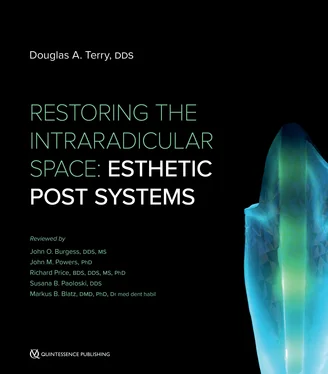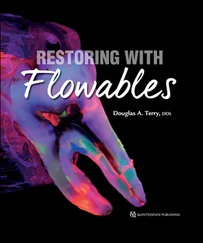1
ESTHETIC POST SYSTEMS
HISTORICAL PERSPECTIVE
For over 250 years, clinicians have written about the placement of posts in the roots of teeth to retain restorations. 1 , 2As early as 1728, Pierre Fauchard described the use of “tenons,” or metal posts screwed into the roots of teeth to retain bridges. 1 , 3 – 6In the mid 1800s, wood replaced metal as the post material, and the “pivot crown” became popular among dentists; this was a wooden post fitted to an artificial crown and the canal of the root. 1 , 2 , 7Often these wooden posts would absorb fluids and expand, frequently causing root fractures. 4 , 7In the late 19th century, the “Richmond crown,” a single-piece post-retained crown with a porcelain facing, was engineered to function as a bridge retainer. 2 , 7During the 1930s, the custom-cast post and core was developed to replace the one-piece post crowns. This procedure required casting a post and core as a separate component from the crown. 7This two-step technique improved marginal adaptation, allowed variation in the path of insertion of the crown, 1and provided a better alignment of the core when the tooth being restored was flared or overlapped the adjacent tooth. In the 1990s, tooth-colored fiber posts debuted as an alternative to these conventional metal post systems. 8 – 17
From the past to the present, the rationale for the utilization of a post system has metamorphosed. The concepts of the past were designed with the belief that endodontically treated teeth (ETT) were brittle from a loss of moisture 18 , 19and required a post to strengthen the weakened tooth. 20 – 26Although there is a reduction in moisture content after endodontic treatment, current concepts refute this postulate. 18 , 19 , 27 – 36Current concepts supported by evidence-based research indicate that the primary objective of any post and core system is to replace missing coronal tooth structure, to retain the core, 37 – 44and to provide sufficient retention 41 , 43 , 45 – 54and resistance form to the final restoration to restore original form and function. 37 – 39 , 55 – 69Today, clinicians can choose from a variety of user-friendly post and core systems 29 , 70 – 81for different endodontic, restorative, and esthetic requirements. These systems and methods are well documented in the literature. 23 – 25 , 29 , 40 , 42 , 80 – 99However, no single post system meets the demands for favorable biomechanical compatibility 65 , 80 , 100 – 102or provides the perfect restorative solution for every clinical circumstance, and each situation requires an individual evaluation. 82
Furthermore, the reconstruction of ETT can present restorative and esthetic challenges for the technician and the clinician. 9 , 80 , 103 – 105The failure of these post-retained systems has been documented in numerous clinical studies. 22 , 39 , 45 , 51 , 66 – 68 , 101 , 106 –150 Many of these studies indicate that the failure rate of restorations on pulpless teeth with posts and cores is higher than that for restorations of vital teeth 106 ,151 –163 because of their structural differences and the significant loss of tissue. 36Several main causes of failure of post-retained restorations have been identified, including recurrent caries,164 ,165 endodontic failure,165 periodontal disease,165 post dislodgment,165 cement failure,166 post-core separation,165 crown-core separation,165 loss of post retention, 40 ,164 core fracture,152 loss of crown retention, 40 ,164 post distortion,164 post fracture, 40 ,152 ,164 ,166 tooth fracture,152 ,166 root perforation, 40and root fracture. 40 ,152 ,164 ,167 ,168 Also, corrosion of metal posts has been proposed as a cause of root fracture.152 A post and core system fabricated with dissimilar metals can cause galvanic corrosion that occurs between the two dissimilar materials. 19 ,169 This gradual destructive process involves the electrical interaction of at least two different metals or nonmetallic conductors in an environment (ie, microleakage) that accelerates the corrosion of at least one of them, while the least noble metal corrodes the most (for more information, see the section entitled “Lack of corrosiveness” later in this chapter).
The traditional custom-cast dowel core provides a better geometric adaptation to excessively flared or elliptical canals and almost always requires minimal removal of tooth structure. 1Custom-cast posts and cores adapt well to extremely tapered canals or those with a noncircular cross section and/or irregular shape and roots with minimal remaining coronal tooth structure. 82 , 89Patterns for custom-cast posts can be formed either directly in the mouth or indirectly in the laboratory. Regardless, this method requires two appointment visits and a laboratory fee. Also, because it is cast in an alloy with a modulus of elasticity that can be as high as 10 times greater than that of natural dentin, 55this possible incompatibility and rigidity can create stress concentrations in the less rigid root, resulting in post separation or failure.170 –172 Additionally, the transmission of occlusal forces through the metal core can focus stresses at specific regions of the root, causing root fracture 55( Fig 1-1). Furthermore, upon esthetic consideration, the cast-metal post can result in discoloration and shadowing of the gingiva and the cervical aspect of the tooth173 ( Fig 1-2).
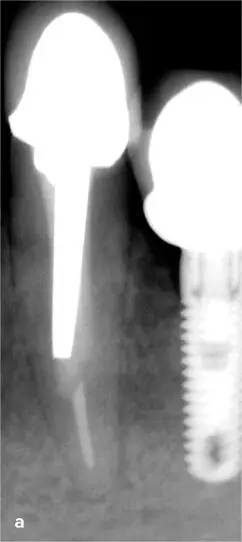
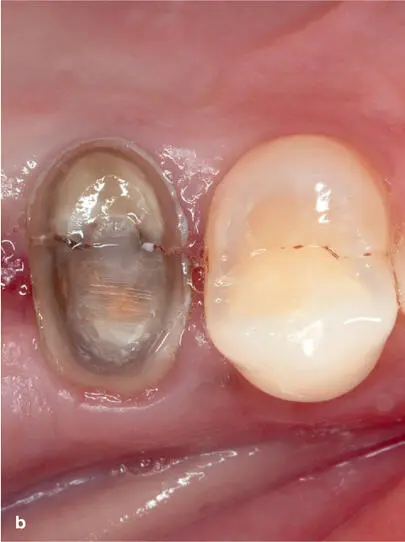
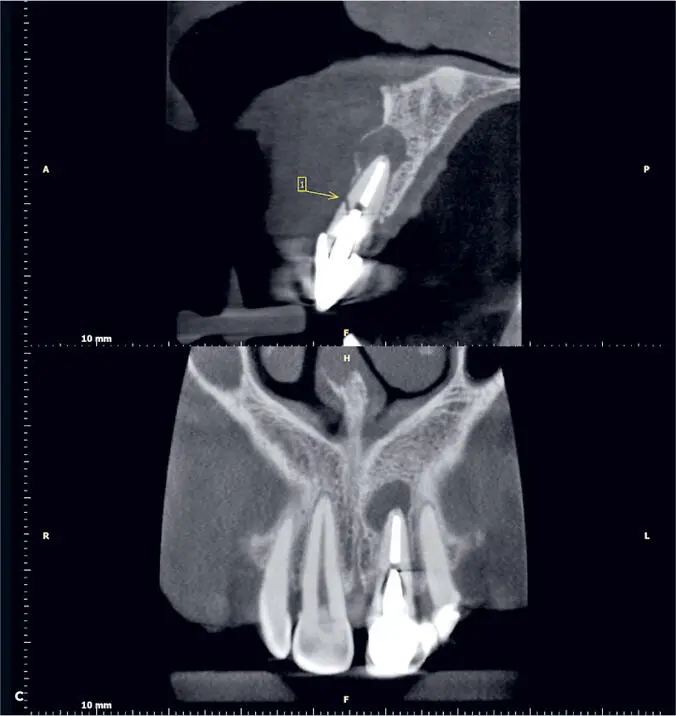
Fig 1-1 (a) Occlusal forces are transmitted through the metal post in the mandibular right canine, and stress concentrations are focused in the mesial aspect of the apical one-third of the root, resulting in a horizontal fracture. (b) A vertical fracture occurs in the maxillary right second premolar with a metal post present. (c) A CBCT shows a horizontal fracture in the maxillary left central incisor. (Radiograph courtesy of Ritu Sharma, BDS, MDS.)

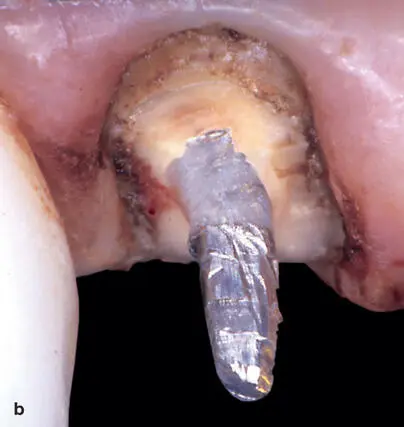
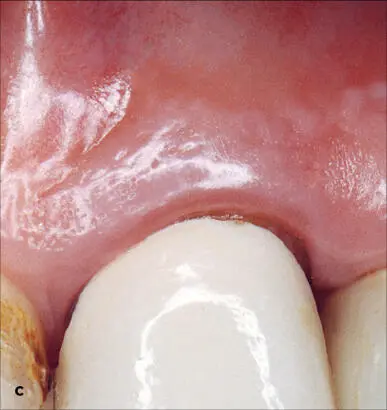
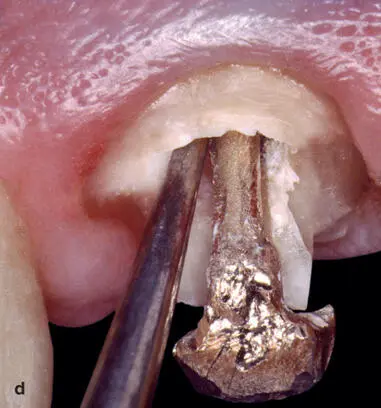
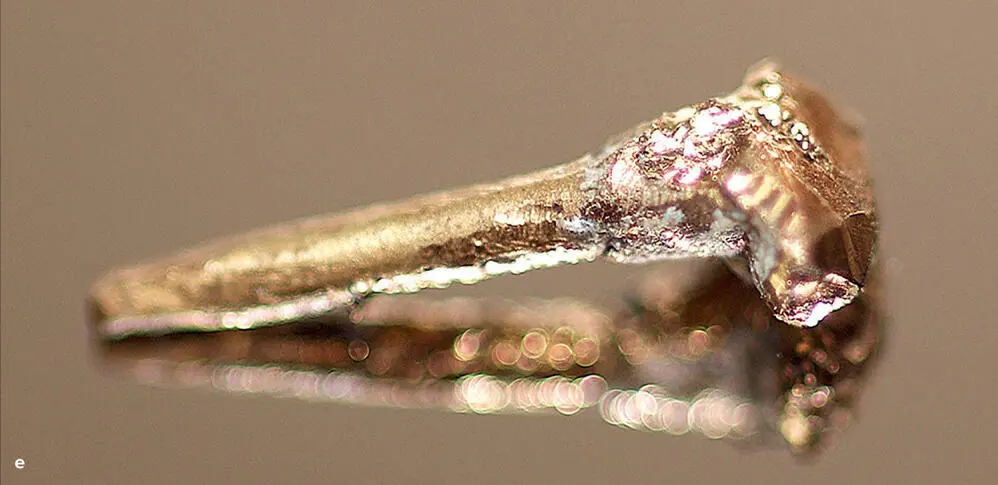
Fig 1-2 (a and b) A maxillary right lateral incisor is restored with a cast-metal post. This can result in discoloration and shadowing of the gingiva and the cervical aspect of the tooth. (c to e) The incidental light is completely blocked by the metal post and the underlying metal framework of the crown, which causes the characteristic shadow at the submarginal zone.
An alternative and currently more popular method is the prefabricated post and core system. Prefabricated post and core systems are classified according to their geometry (ie, shape and surface configuration) and method of retention. The methods of retention are designated as active or passive. Active posts engage the dentinal walls of the post space preparation during cementation, whereas passive posts do not engage the dentin but rely on cement for retention. 1 ,174 The basic post shapes and surface configurations are tapered serrated, tapered smooth-sided, tapered threaded, parallel serrated, parallel smooth-sided, and parallel threaded. While active or threaded posts are more retentive175 –178 than passive posts, active posts create high stress concentrations in root dentin at each thread during placement.177 ,179 –184 These stresses have the potential to create cracks185 ,186 that can increase the susceptibility of root fracture127 ,184 when occlusal forces are applied. 10Thus, a significant cause of failure with an active post system is root fracture. 52 ,184 ,187 ,188 More recent modern designs provide a collar that limits insertion, flexible tips (FlexiPost), and stress-reducing thread design. Metal screws have a survival rate of 78%127 ,184 after 1 year and 50% after 5 years.184 Parallel-sided serrated posts are the most retentive of the passive prefabricated posts, and the tapered smooth-sided posts are the least retentive of all designs. 7
Читать дальше
